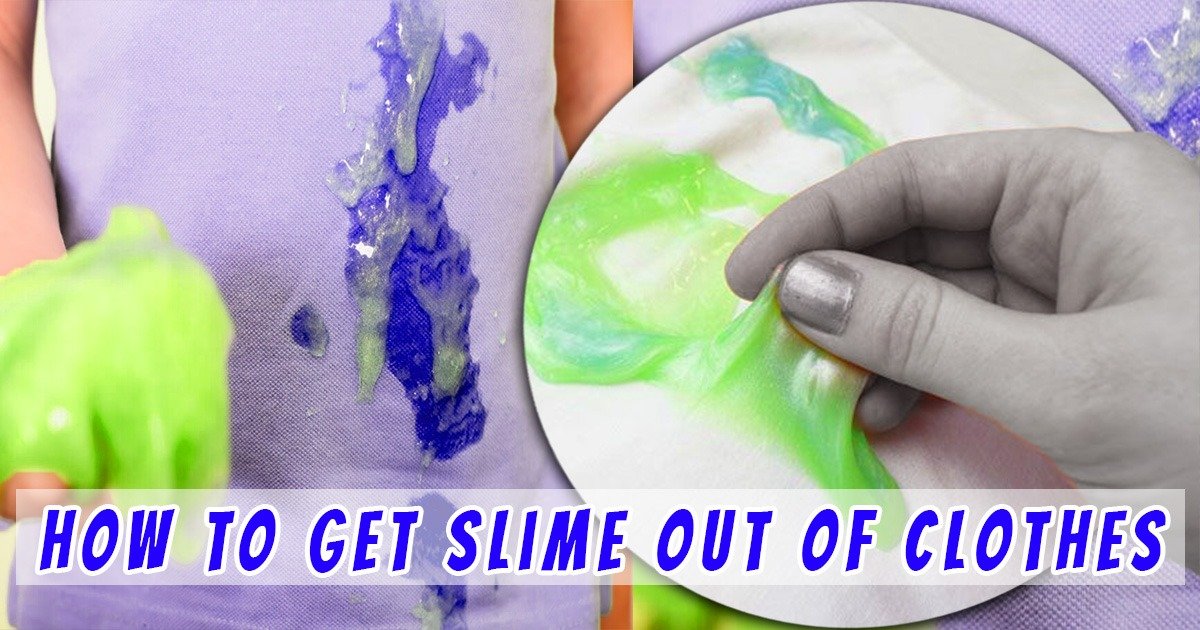Slime stains are a common problem, especially for families with young children who love crafting or playing with slime. Slime is fun and gooey but can be quite troublesome when it gets on clothing. The key to successfully removing slime is to act quickly and use the right methods. This guide will walk you through various techniques of How to Get Slime Out of Clothes , including whether washing alone is effective, how ice can help, and if hand sanitizer can be used as a stain remover.
Does Slime Come Out in the Wash?
One of the most common questions is whether slime comes out in the wash. The answer depends on several factors, including the type of slime and the fabric of the clothing. For many slime stains, a regular wash may not be enough to fully remove the residue. Slime often contains ingredients like glue, which can adhere to fibers and require more than just water and detergent to remove. However, washing is still an essential step. Start by rinsing the affected area with cold water to remove as much slime as possible before washing. Use a stain remover or pre-treatment spray designed for greasy or sticky stains to boost the effectiveness of your wash.
Can Ice Remove Slime from Clothes?
Using ice to remove slime from clothes is a lesser-known but effective method. Ice helps to solidify the slime, making it easier to scrape off. To use this method, place ice cubes in a plastic bag and hold the bag against the slime-stained area. After a few minutes, the slime should harden and become less sticky. Gently scrape off the hardened slime with a spoon or a dull knife. Be careful not to damage the fabric while scraping. Once you’ve removed the bulk of the slime, treat the stain with a stain remover and wash the clothing as usual. This method works well for fresh slime stains and can be an excellent first step before more intensive cleaning.
What is the Best Stain Remover for Slime?
When it comes to removing slime stains, using the right stain remover can make all the difference. Look for products specifically designed for sticky or greasy stains. Enzyme-based cleaners are particularly effective as they break down the proteins in the slime, making it easier to remove. Some popular options include OxiClean MaxForce, Zout Laundry Stain Remover, and Shout Advanced Gel. Apply the stain remover directly to the slime stain, and let it sit for at least 5-10 minutes before washing. Always check the product’s label to ensure it’s safe for the fabric you’re treating. For delicate fabrics, consider testing the stain remover on a small, inconspicuous area first.
Does Hand Sanitizer Remove Slime?
Hand sanitizer is a surprising but effective tool for removing slime stains. The alcohol in hand sanitizer helps to break down the slime’s sticky components. To use hand sanitizer, apply a generous amount to the slime-stained area and gently rub it in with your fingers or a cloth. Let it sit for a few minutes to allow the alcohol to work on the slime. Afterward, rinse the area with cold water and check if the stain has lifted. If necessary, repeat the process or follow up with a stain remover and wash the clothing as usual. Hand sanitizer is a convenient option if you don’t have access to other stain removers.
DIY Slime Stain Removers: Home Remedies
For those who prefer natural or homemade solutions, several DIY methods can effectively remove slime stains. One popular home remedy involves using white vinegar and baking soda. First, sprinkle baking soda over the slime stain, then apply a mixture of white vinegar and water. The combination will fizz and help lift the slime from the fabric. After treating the stain, rinse the area with cold water and wash the clothing. Another effective remedy is using lemon juice and salt. Apply lemon juice directly to the stain, sprinkle salt on top, and gently scrub with a brush or cloth. Rinse thoroughly and launder as usual. These DIY methods are helpful for those seeking non-commercial solutions.
Step-by-Step Guide to Removing Slime from Clothes
- Act Quickly: The sooner you address a slime stain, the easier it will be to remove.
- Remove Excess Slime: Gently scrape off as much slime as possible using a spoon or dull knife.
- Use Ice if Necessary: Apply ice to harden the slime and make it easier to scrape off.
- Apply Stain Remover: Choose a stain remover suitable for sticky or greasy stains and apply it to the affected area.
- Launder as Usual: Wash the clothing in the warmest water safe for the fabric.
- Check the Stain: Before drying, check if the stain is completely removed. If not, repeat the process.
- Dry: Once the stain is gone, dry the clothing as per the care instructions.
Tips for Preventing Slime Stains on Clothing
Preventing slime stains is easier than removing them. Here are some tips to keep your clothes slime-free:
- Protective Clothing: Wear old clothes or aprons when playing with slime to minimize the risk of staining.
- Surface Protection: Use a disposable tablecloth or old newspaper to protect surfaces where slime is used.
- Immediate Cleanup: If slime gets on clothing, address the stain immediately to prevent it from setting.
How to Wash Clothes After Removing Slime
After successfully removing slime stains, it’s important to wash the clothing properly. Follow the care label instructions, using the appropriate water temperature for the fabric. Add a quality detergent and, if needed, a booster like oxygen bleach to ensure thorough cleaning. Avoid drying the garment until you’re sure the stain is completely gone, as heat can set any remaining residue.
How to Remove Slime from Delicate Fabrics
Removing slime from delicate fabrics like silk or wool requires extra care to prevent damage. Start by gently scraping off any excess slime with a soft cloth or a spoon, taking care not to push it further into the fabric. Avoid using ice on delicate fabrics as it might cause damage. Instead, gently blot the stained area with a cloth soaked in cold water to loosen the slime. Apply a small amount of mild detergent or a specialized stain remover suitable for delicate fabrics. Test the remover on a small, inconspicuous area first to ensure it does not cause discoloration or damage. Gently rub the area with your fingers or a soft brush to work the product into the stain. Rinse thoroughly with cold water and then air dry the garment. For extremely delicate items, consider taking them to a professional cleaner to avoid any potential damage.
How to Treat Slime Stains on Carpets and Upholstery
Slime stains on carpets and upholstery require a different approach than those on clothing. Start by gently scraping off as much of the slime as possible with a spoon or blunt knife. Be careful not to push the slime deeper into the fibers. Blot the affected area with a cloth or paper towel to absorb any excess slime. Mix a solution of warm water and mild dish soap, and use a clean cloth to apply it to the stained area. Gently blot and scrub the stain with the cloth, working from the outside in to avoid spreading the stain. Rinse with clean water and blot dry with a towel. For tougher stains, a mixture of vinegar and baking soda can be used. Sprinkle baking soda over the stain, then spray with a mixture of vinegar and water. Allow it to fizz and work on the stain, then blot and rinse. For stubborn stains or delicate fabrics, consider hiring a professional cleaner.
How to Remove Slime from Washable and Non-Washable Fabrics
Slime removal techniques vary based on whether the fabric is washable or non-washable. For washable fabrics like cotton or polyester, follow the standard methods of stain removal: scrape off excess slime, apply a stain remover, and wash according to the care label. For non-washable fabrics, such as those found in some upholstery or delicate clothing, alternative methods are required. For non-washable items, start by blotting the stain with a clean cloth to remove as much slime as possible. Use a fabric-safe cleaner or a mixture of water and mild detergent applied with a cloth or sponge. Gently blot and avoid over-wetting the fabric, which could lead to further damage. For very delicate non-washable fabrics, consider consulting a professional cleaner to ensure the stain is removed without compromising the fabric’s integrity. These methods will help preserve the appearance and longevity of both washable and non-washable fabrics.
Conclusion: Effective Slime Removal Strategies
Removing slime from clothes requires a combination of quick action and the right methods. By understanding whether washing alone is sufficient, how to use ice effectively, and the role of hand sanitizer and stain removers, you can tackle slime stains with confidence. Remember to follow preventative measures to avoid future stains and always check fabric care labels before applying treatments. With these strategies, you can keep your clothes clean and enjoy slime play without worry.

Evelyn White is an experienced content writer with a background in lifestyle, trends, and practical advice. With several years of writing across digital platforms, she specializes in making everyday topics accessible, informative, and engaging. Her goal is to deliver trustworthy, reader-focused content that’s both useful and easy to understand.
Discover more from Try Hard Guides
Subscribe to get the latest posts sent to your email.

